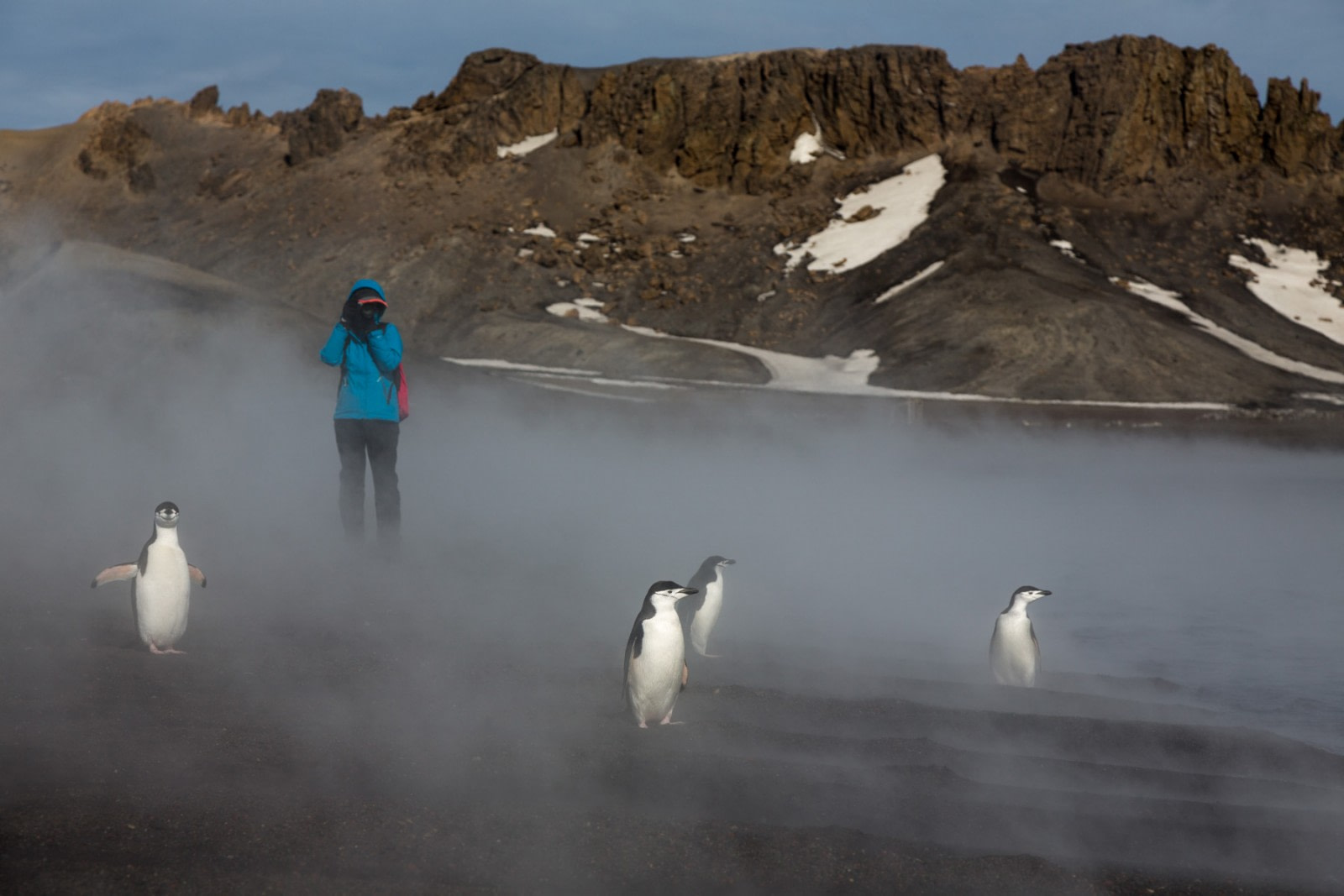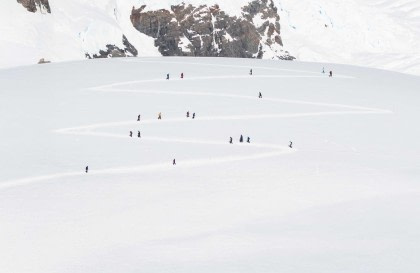The ins and outs of an Antarctica cruise
Like many of life’s most rewarding experiences, an Antarctic expedition takes some preparation and knowledge. You’ll be sailing into one of the most hostile environments on the planet, and it’s not an undertaking that should be lightly taken.
With that in mind we’ve set up this guide to get you set for your voyage. In it you’ll find clothing tips, tidbits of history, guidelines for how to get along on the ship, and so on. Everything you’ll read is based on years of experience, set down here to help you get the most out of your adventure in the safest manner possible.
Aboard the ship
Life aboard our ships is important enough to warrant its very own A to Z list. Some of these guidelines are for safety, others are to enhance your Antarctica cruise enjoyment.
Announcements – Don’t worry that you’ll miss anything exciting while onboard. Our crew announces every major event, such as wildlife sightings, in English. Depending on the ship and cruise, we may also make announcements in a second language.
Bar – This is the social hotspot of the ship. Meet your fellow adventurers and compare martini recipes here. Hot drinks (coffee and tea) are available free at all times. The bar is a non-smoking area.

Books – We have a selection of books, both reference and fiction, in our library. We prefer that reference books (marked with polar stickers) remain in the library, but the paperbacks are free to wander around the ship with you.
Bridge – The command centre of the ship, this is a great place to keep a watch out for the scenery, wildlife, and to catch a glimpse of how a ship is run. Please do bear in mind however that the bridge is a working place; so stay to one side and refrain from eating or drinking. On occasions of rough weather or when the ship is in port, the bridge may be closed to visitors for safety reasons. When in doubt check with the officer on watch.

Picture by Jamie Scherbeijn
Communication – You are able to make calls and send emails via Iridium satellite connections. The costs are at your expense.
Crew Areas – Please do not enter crew areas.
Currency and Payment – Bar tabs and souvenirs will be charged to your cabin. The day before your departure you can settle your bill with the hotel manager. Prices and the standard currency are in Euros. Other currencies may be accepted (at the current exchange rates) at the discretion of the hotel manager. Payments can be made via:
- Cash (Euros or U.S. Dollars)
- Maestro (except on Rembrandt van Rijn)
- Visa
- MasterCard
- Diners Club
- Discover
- Union pay
Note: Aboard the s/v Rembrandt van Rijn payments can be made in cash Euros, US Dollars, or with Visa or MasterCard. We do not accept cheques of any kind.
Daily Program – Displayed on monitors and/or on a whiteboard. While we endeavour to keep you as up-to-date as possible, we are after all on an adventure and events can change at a moment’s notice. If a lecture is interrupted by an event (like a whale sighting) we will reschedule it at the next opportunity.
Dress code – We have no formal dress code on our vessels other than our suggestion to wear warm, comfortable clothing and shoes with good grip. Indoors the temperature is kept quite warm and comfortable; however at any moment’s notice you may wish to rush outside because of a whale sighting. Out on the decks the air will be much cooler and the deck will likely be slippery. So keep your layers and non-slip boots close by at all times.
Doctors – We have infirmaries on board our motored ships stocked to handle small injuries and render first aid assistance. If you’re feeling ill please don’t hesitate to contact the doctor. If you take special medications or are allergic to certain medications please inform our Doctors ahead of time. In case of emergencies we’ll need to know if any special treatments are necessary. Note: There is no doctor or infirmary on board sv Rembrandt van Rijn.
Electric current – 220v, 60Hz, with the standard European 2 round pins on the plug. North Americans will need a 220/110 volt converter.
Equipment - We provide free rubber boots available for loan on Plancius, Ortelius, and Hondius. Other specialized equipment (camping, snowshoes etc…) will be provided for the activities booked.
Gratuities – Usually gratuities for the Antarctic cruise ship’s service personnel is made as a blanket contribution in one envelope at the end of the voyage to be divided among the crew and staff. If you prefer you can however approach individual crew and staff. The amount is entirely up to you. Cash works best (U.S. Dollars or Euros).
Language – All staff and crew of our Antarctic cruises speak English. In addition, several of our cruises are dedicated to certain language groups like German, in which case there will of course be German-speaking staff aboard to welcome you and give safety briefings, announcements, daily briefings, and recaps. The English and German lectures may vary in content. The language of the activities on land will depend on which group a passenger chooses according to their physical ability. There are usually 3 varieties of land activity groups - a strenuous hiking group, a moderate-paced group with more time for photography, and a slower leisurely group. A German-speaking staff member will not necessarily be provided each time. During Zodiac cruises the boat’s driver and guides won’t necessarily be bilingual.
Laundry - Although limited, there is a laundry service on board (but not on s/v Rembrandt van Rijn). In your cabin you will find laundry forms and linen bags. You simply have to fill out the form, put the laundry in the provided bag, and then leave it on the bed. Your laundry will be picked up by a cabin stewardess and returned within 24 hours. Dry cleaning is not available.
Life jackets – While on your Antarctic cruise you will be given a lightweight inflatable life jacket which inflates automatically on contact with water. These life jackets are mandatory at all times in our Zodiacs. Please refrain from getting the life jacket wet; do not leave it lying exposed to rain. Always bring the life jacket back to your cabin. You should also wear your inflatable life jacket when it is windy outside on deck. We also provide you with additional “heavy duty” bright orange life jackets in the cabins which are to be used in case of emergency and during the lifeboat drill.
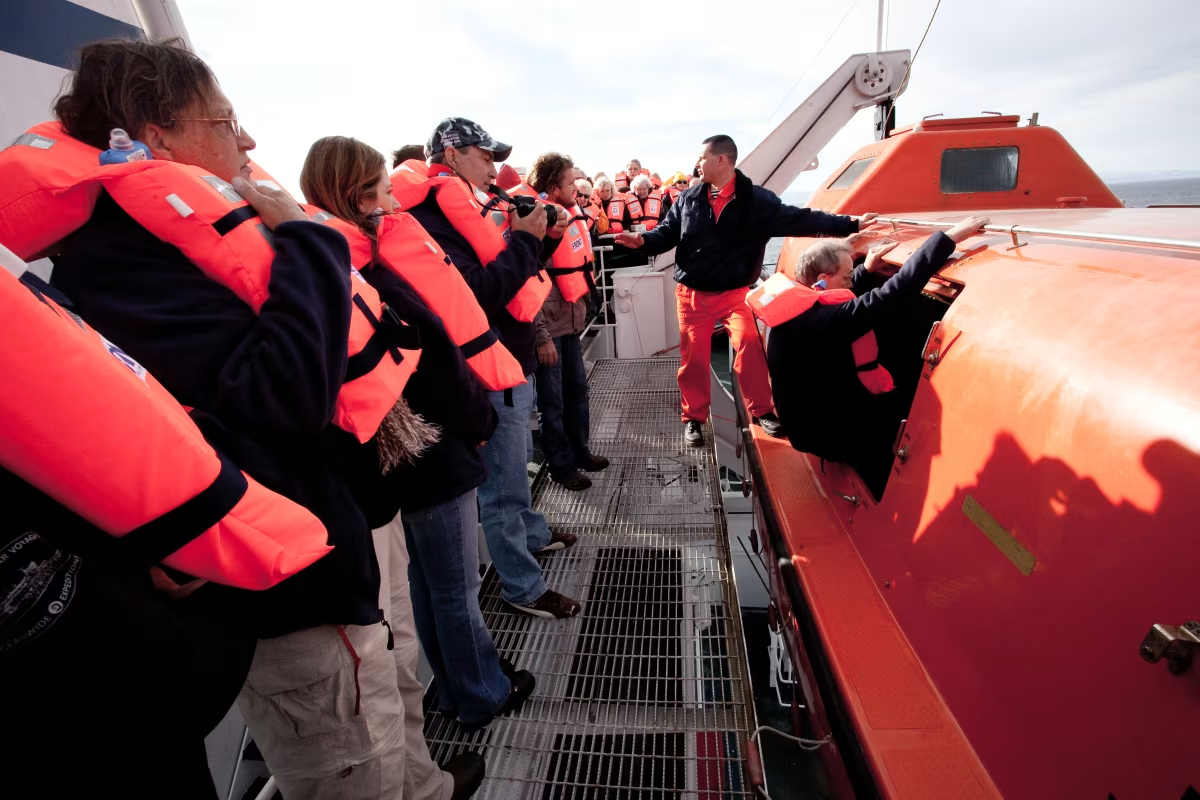
Picture by Hanneke Dallmeijer
Mealtimes and dietary requirements - All meal-times are announced during your Antarctic cruise. You can inform our hotel manager ahead of time of any dietary requirements so our chefs have time to make something special for you. Vegetarian and vegan meals must be requested before your Antarctic cruise departs via the Personal Information Form (PIF) with the reservation department. Normal mealtimes are:
- Breakfast 07:30
- Lunch 12:30
- Dinner 19:00
Safe – We do have a safe available on board our vessels. The hotel manager will be happy to secure your valuable items.
Safety – We always start our Antarctic cruises with a mandatory life jacket and life boat “abandon ship” drills. It’s possible that during the voyage the Master may perform an additional fire drill, this will be announced. We do cross rough waters so you should anticipate pitching and rolling. There can also be sudden lurches and stops as the ship works its way through the ice. Use handrails whenever possible, especially going up stairways, ladders etc…
- Be careful while walking on open decks, they can be very slippery.
- Please watch your step going out on deck, many doorways have high steps.
- Don’t place your hands on the edge of the doors - a lurching movement could slam the door on your fingers.
- While onboard please remember: one hand for yourself, one hand for the ship.
Smoking – Smoking is prohibited while indoors on our ships. You can smoke outside on the deck but please don’t throw your cigarette filter overboard! Also please don’t smoke on the aft deck near the Zodiacs, engines and fuel. Please respect the wishes of non-smokers.
Souvenirs - T-shirts, sweaters, postcards etc… are available in the souvenir shop. Opening hours will be announced.
Tag board - Before and after going on landings or Zodiac cruises all guests are required to sign on/off the ship. This is done using your cabin key card provided to you on board.
Wildlife watch – Our Antarctic cruise officers and staff are constantly on the lookout for wildlife, but you’re part of our spotting team too! Report your sightings to the staff or officers on the bridge. Special wildlife sightings are announced from the bridge to all cabins and decks, regardless the hour, so you won’t miss a thing. However it’s not mandatory for you to scramble for the binoculars – if you’d prefer to return to sleep it’s entirely up to you.
Age range
Overall our Antarctic cruises get an age range of people in their 30s through their 80s. On average the range on our motorized vessels is about 45 to 65, the range on our sailing vessels being a little lower.
As a rule Oceanwide Expeditions attracts people who want an adventure outside the normal range of “touristy” activities, characterized by a desire to investigate the less-explored areas of the world.
We attract people from all over the world, and the comradery that develops during a cruise inevitably becomes an important part of your expedition experience.
Clothes
There are three rules of thumb for picking out your Antarctic cruise kit:
- Keep warm
- Keep dry
- Layer yourself
Remember, you’re not just fighting off the cold. You’re also trying to keep the wind at bay.
The “wind chill factor” measures how much of your heat can be carried off by wind versus the chill of still air alone. A breeze of only 5 km per hour can steal away more than 8 times your body heat than still air.
That’s why we humbly suggest making your outer layer be a windbreaker, preferably waterproof. Under that you’re going to want loose layers – tight clothing does not allow for a layer of air between your skin and the clothing. Trapped air will grow warm thanks to your body-heat, returning the favour by keeping you warm.
Try to avoid cotton if you can. Silk, wool, and synthetic fibres like polar fleece are much more effective insulators.
Layering is a better choice over one or two super-heavy clothing items. You’ll have a much better time maintaining your comfort if you’re able to add or strip away layers to adjust your own temperature.
Speaking of temperatures, you’re probably wondering how cold it gets on your Antarctic cruise. The Antarctic summers usually range around the freezing mark plus the wind-chill, but out in the Ross Sea between it can get down to -10°C (14°F).
Here’s our handy suggested packing list:
Trousers – You’re going to want something that can fit comfortable between long underwear and an outer waterproof layer. Nothing too tight-fitting – you want to be able to create your warm air layers. Jeans and corduroys can fit this bill – and they’re comfortable for wearing when you’re aboard the ship. Also, waterproof pants are essential for keeping dry and warm. They should fit comfortably over your other lower layers. Gore-Tex or a similar product is both comfortable and waterproof.
Thermal Underwear - Polypropylene or silk is tops since it keeps you warm without being overly bulky. How thick or warm it should be entirely depends on your own personal comfort levels.
Sweaters, Turtlenecks, and Polar Fleece Jackets – Any combination of these three as your top’s middle layers are recommended and are comfortable while you’re on the ship.
Mittens and Gloves – Hands and feet represent a lot of surface area with little body mass, which means they’re prone to giving up heat. If you intend to take a lot of pictures, we suggest you wear thin polypropylene gloves under your mittens – you can pop off your mittens and snap your pics while still having some protection. Also, they’re bound to get wet, so bring extras.
Woolen Cap – Your mom was right, you can lose a whole lot of heat out of your head – so wear your hat young man and/or lady! You can lose up to 90% of your lost body heat through your head, so pop something onto your top. Preferably you should have a hat that can also cover your ears.
Scarf – To protect your neck and make you look extra jaunty as you venture forth. The penguins will be impressed.
Socks – Your feet will most probably get wet on your Antarctic cruise, so make sure to bring extra pairs. We suggest layering here too – thin silk, polypropylene, or cotton/wool socks underneath with a pair of sturdy and tall wool socks on top.
Waterproof and Windproof Jacket – Your jacket must fit comfortably over your other layers of clothing and must keep you dry. Facing Antarctic winds with wet clothing is not anyone’s definition of fun. Gore-Tex or sailing gear is your best bet, although it is possible to find more economical versions of outerwear.
Backpack – If you’re bringing a camera you’re going to want to bring a backpack, and a waterproof one at that. Every year someone’s camera dies a grisly watery death during a ride in a Zodiac. Also, get a backpack with straps as you’re going to want to keep your hands free.
Sunglasses – The glare off of the water and ice can be quite piercing. Besides, you’ll look extra cool in the pictures you send home if you have sunglasses on.
Binoculars - Let’s you see things. Also makes you look extra cool in pictures.
Camera/Film/Memory Cards – You might want to consider bringing 2 cameras; there is many a method for one to kill a camera on an Antarctic cruise – dropping it overboard, getting it splashed while on the Zodiac, and so on. Along those same lines, we’d suggest bringing double the amount of film or memory cards that you originally intended to bring. You may lose some to damage or take more pictures than you expected.
Earplugs – Your cabin-mate might be a snorer. You have been warned!
Teva Sandals – For your time on board the ship. Please note that for safety reasons you should have a version of sandal that has a heel strap.
T-shirts – For your time on board the ships. Our ships are all comfortably warm.
Rubber Boots (very important!) – When you’re stepping off of a Zodiac onto land you’re sure to step in water. It’s very important to keep your feet dry, which is why good rubber boots are of the utmost importance. The boots should be pull-on, made of rubber, completely waterproof, go to mid-calf or higher, and with a strong, ridged non-slip sole. This is so important that you may be refused landings if you do not have the proper footwear. (Passengers on board our motor vessels will be given returnable rubber boots as part of their order. The order forms with your sizes must be given to us at least eight weeks before departure.) We suggest “Wellies” or “Viking” boots with waffle soles.
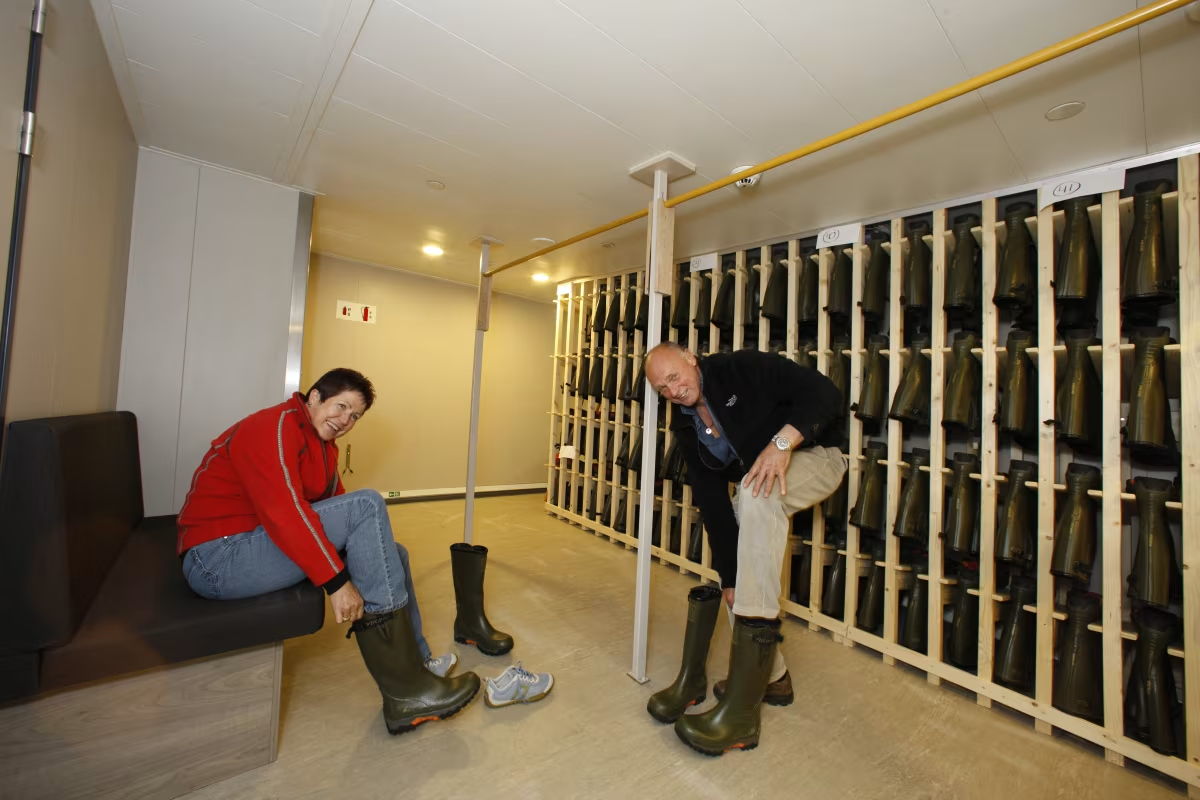
Picture by Heiner Kubny
Documents
You will absolutely want to bring your passport with you. As for visas, it depends on where you’re travelling to, and where you’re travelling from. Your best bet is to ask at your nearest consulate, or you can start your visa info search with Visamapper.
Drones
In order to be able to fly an Unmanned Aerial Vehicle (UAV) or drone of any kind in Antarctica requires a permit from a competent body of your own country. Oceanwide Expeditions does not have such a permit from the Dutch authorities. Therefore Oceanwide Expeditions does not allow the flying of UAVs/ drones by our passengers.
Fitness and health
You don’t have to be a rugged athlete to enjoy our trips, but you should be in good general health and able to enjoy walking for a few hours at a time. Much of the cruise revolves around ship life, and you are by no means required to join hikes, but you may miss out on some of the adventure if you’re unable to come ashore.
You’ll also have to be able to make your way down a fairly steep gangway to transfer from the ship to the Zodiacs. Our lovely and talented staff will help you make the actual transition from one to the other.
Also please do keep in mind that we will be landing in rugged stretches of wilderness where there are no hospital facilities available. So if you have a life-threatening condition or you’re unable to take sizable walks everyday then unfortunately our cruises are not for you.
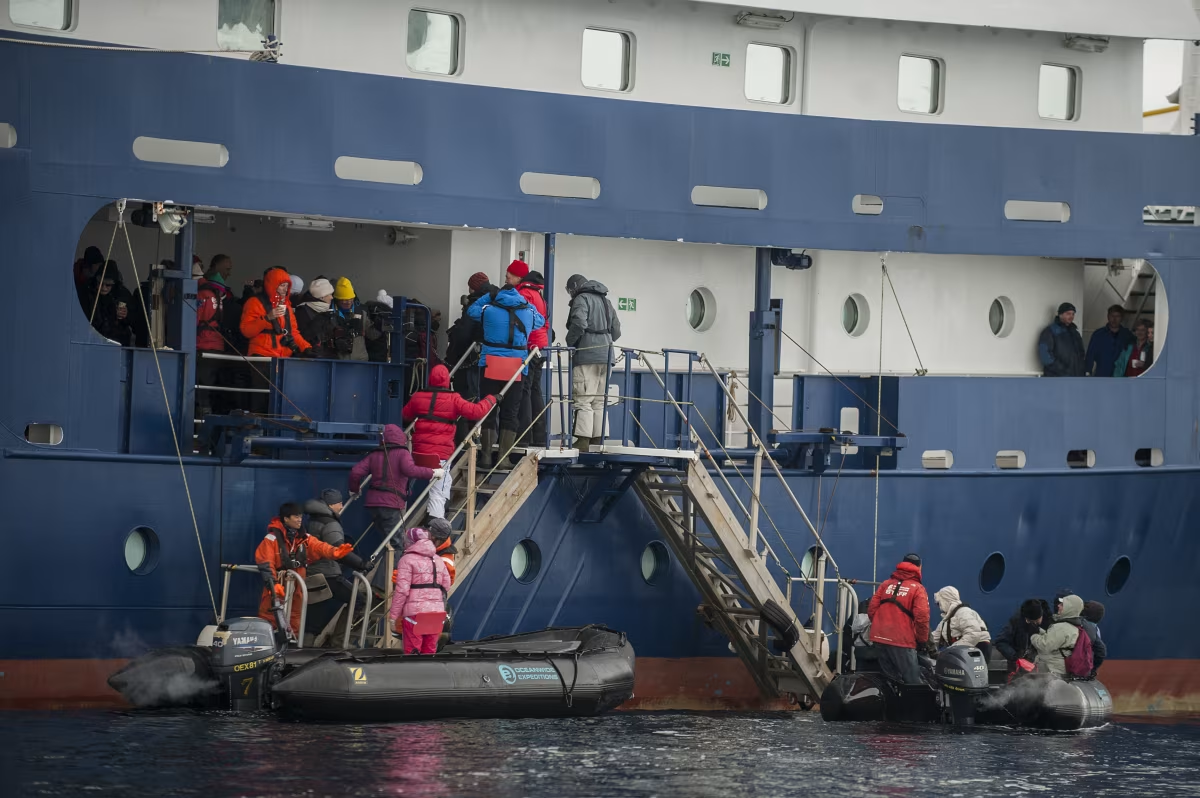
© Morten Skovgaard | Oceanwide Expeditions
Guidelines and restrictions (while on shore)
There are a whole bunch of treaties and contracts between multiple nations governing human activity in the Antarctic. Boiled down, they state that the Antarctic is a place of peace and scientific study, and that we must make sure that human interaction does not adversely affect the environment.
Violations of the various environmental laws can result in a stiff fine – up to $10,000 USD.
Conservation of the wilderness and the wildlife is of utmost concern – we’re visitors, not the owners. We will give you an introductory briefing on our procedures before our first landfall that will best allow you to enjoy the Antarctic while letting the wildlife keep enjoying it after we leave.
Those who take an Antarctic cruise should know that the environment in these areas is especially vulnerable. Birds, mammals and plants are all surviving in the marginal existence zone. Because of seasonal light and low air and water temperatures, life processes are slower, particularly in plant recovery rates.
Wildlife
Taking or harmful interference with Antarctic wildlife is prohibited except in accordance with a permit issued by a national authority.
- Do not use aircraft, vessels, small boats, or other means of transport in ways that disturb wildlife, either at sea or on land.
- Do not feed, touch, or handle birds or seals, or approach or photograph them in ways that cause them to alter their behaviour. Special care is needed when animals are breeding or moulting.
- Do not damage plants, for example by walking, driving, or landing on extensive moss beds or lichen-covered scree slopes.
- Do not use guns or explosives. Keep noise to the minimum to avoid frightening wildlife.
- Do not bring non-native plants or animals into the Antarctic such as live poultry, pet dogs and cats or houseplants.
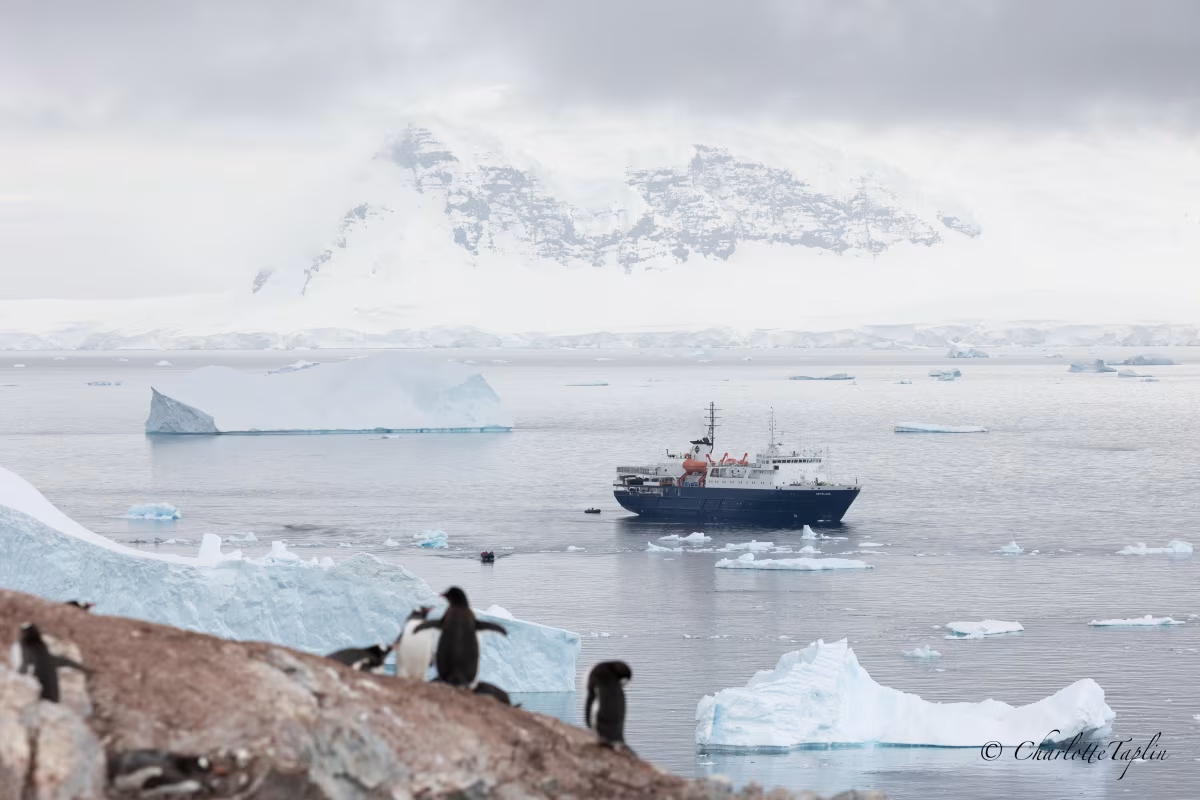
Picture by Charlotte Taplin
Protected areas
A variety of areas in the Antarctic have been afforded special protection because of their particular ecological, scientific, historic or other values. Entry into certain areas may be prohibited except in accordance with a permit issued by an appropriate national authority. Activities in and near designated Historic Sites and Monuments and certain other areas may be subject to special restrictions.
- Know the locations or areas that have been afforded special protection and any restrictions regarding entry and activities that can be carried out in and near them.
- Observe applicable restrictions.
- Do not damage, remove, or destroy Historic Sites or Monuments or any artefacts associated with them.
Scientific research
Do not interfere with scientific research, facilities or equipment.
- Obtain permission before visiting Antarctic science and support facilities; reconfirm arrangements 24-72 hours before arrival; and comply with the rules regarding such visits.
- Do not interfere with, or remove, scientific equipment or marker posts, and do not disturb experimental study sites, field camps or supplies.
Safety tips
Be prepared for severe and changeable weather and ensure that your equipment and clothing meet Antarctic standards. Remember that the Antarctic environment is inhospitable, unpredictable, and potentially dangerous.
- Know your capabilities, the dangers posed by the Antarctic environment, and act accordingly. Plan activities with safety in mind at all times.
- Keep a safe distance from all wildlife, both on land and at sea.
- Take note of, and act on, the advice and instructions from your leaders; do not stray from your group.
- Do not walk onto glaciers or large snowfields without the proper equipment and experience; there is a real danger of falling into hidden crevasses.
- Do not expect a rescue service. Self-sufficiency is increased and risks reduced by sound planning, quality equipment, and trained personnel.
- Do not enter emergency refuges (except in emergencies). If you use equipment or food from a refuge, inform the nearest research station or national authority once the emergency is over.
- Respect any smoking restrictions, particularly around buildings, and take great care to safeguard against the danger of fire. This is a real hazard in the dry environment of Antarctica.
Antarctic environment
Antarctica remains relatively pristine, the largest wilderness area on Earth. It has not yet been subjected to large scale human perturbations. Please keep it that way.
- Do not dispose of litter or garbage on land. Open burning is prohibited.
- Do not disturb or pollute lakes or streams. Any materials discarded at sea must be disposed of properly.
- Do not paint or engrave names or graffiti on rocks or buildings.
- Do not collect or take away biological or geological specimens or manmade artefacts as a souvenir, including rocks, bones, eggs, fossils, and parts or contents of buildings.
- Do not deface or vandalise buildings, whether occupied, abandoned, or unoccupied, or emergency refuges.
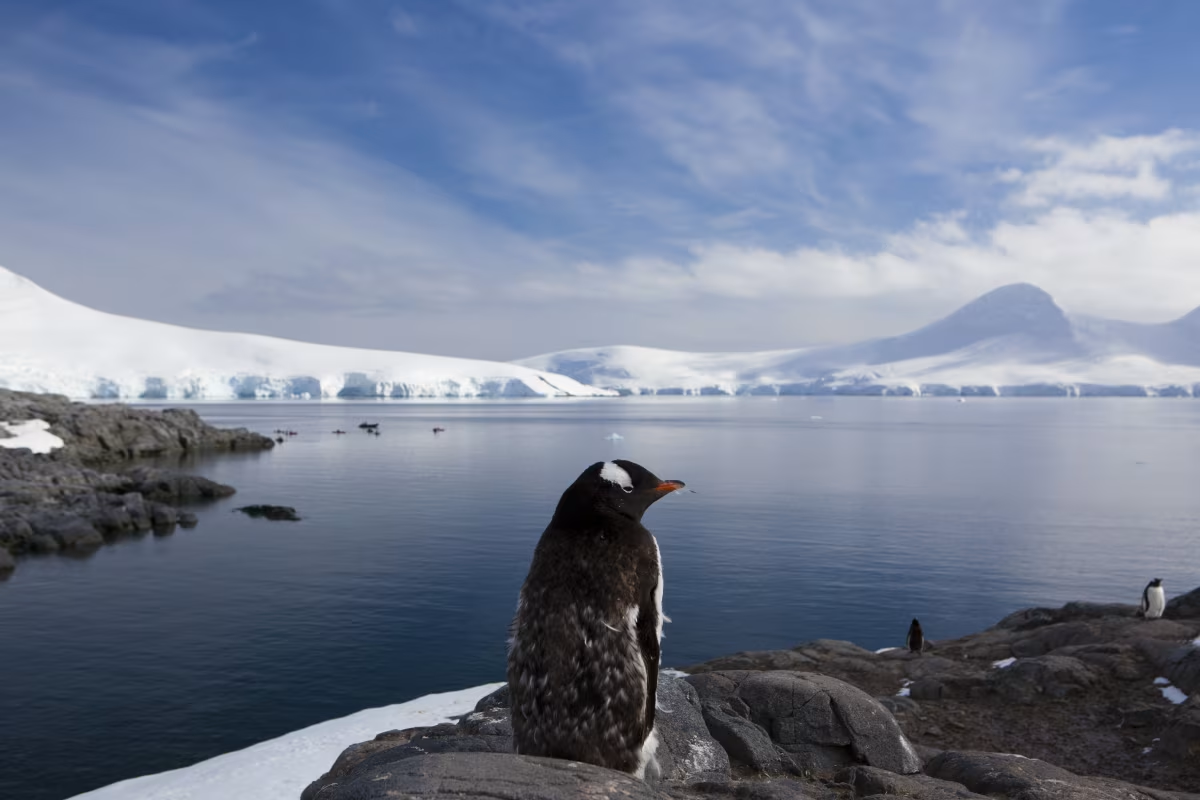
Picture by Richard Wadey
South Georgia and the South Sandwich Islands
The environments of South Georgia and the South Sandwich Islands are very fragile, and the governing bodies take extra special care in making sure that no outside plant or animal life is introduced to tilt the balance.
Before your ship reaches South Georgia the staff will do a bio-check with you, but you can help out before you depart for your voyage.
- Ensure that the footwear you intend to take has been scrubbed clean and all soil and seeds removed.
- Check all of your clothing for soil, seeds and insects, especially cuffs, pockets, seams, hoods and all Velcro.
- Check that any equipment and luggage you plan to bring is clean and free of soil and seeds. This includes walking sticks, ski poles and tripods for cameras.
- Before packing, please vacuum and inspect inside any bags, particularly those that you plan to take ashore, to ensure absence of soil, seeds, and insects.
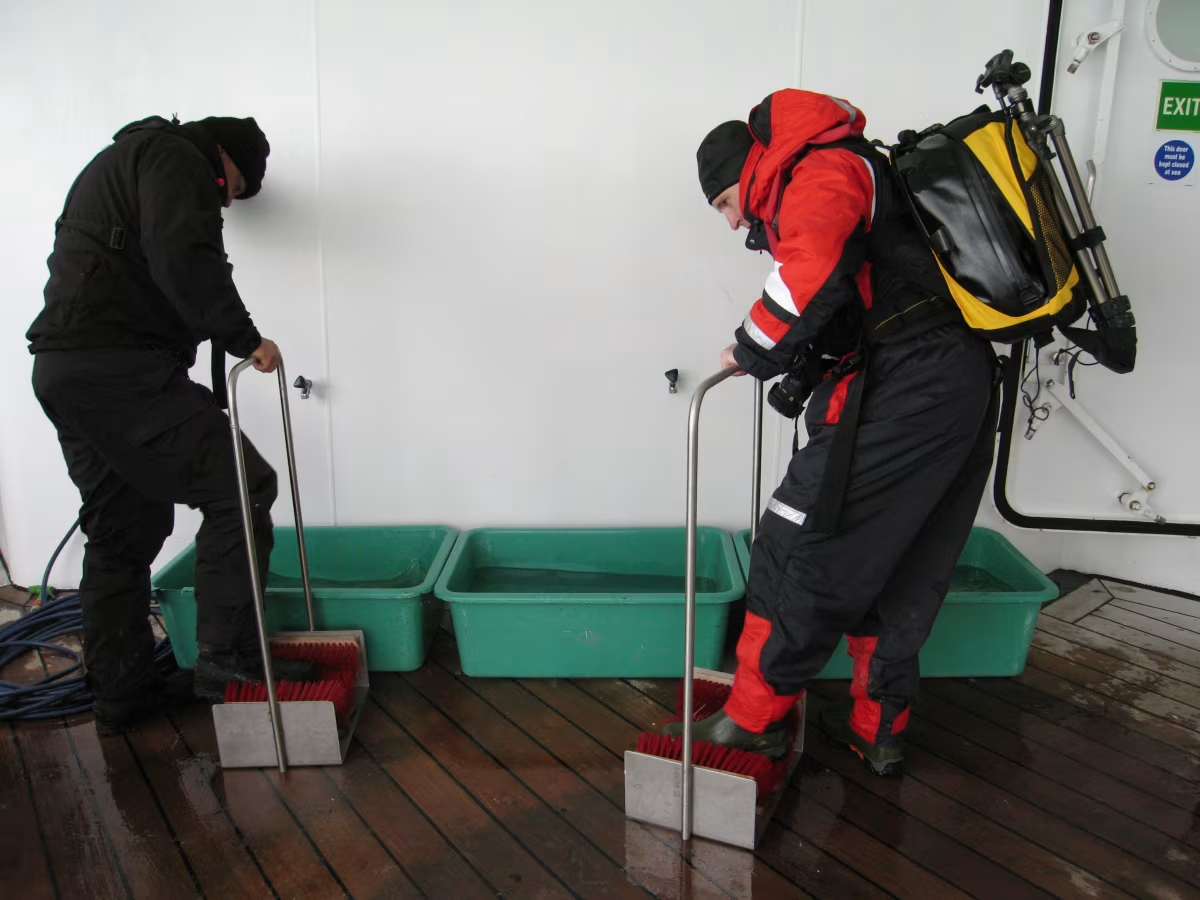
Picture by Joerg Ehrlich
History of Antarctic exploration
While exploration of the far reaches of the North Pole has been going on at least since the age of the Vikings, the South Pole remained a mystery until much more recent times. In fact, it wasn’t really until the late 1800s that explorers started to feel that Antarctica would look much better with a flag pole stuck in it.
The Race to the South Pole
In 1909, the Englishman Robert Falcon Scott resolved to conquer the South Pole. At the same time, the Norwegian polar explorer, Roald Amundsen, was planning an expedition to the North Pole.
When Amundsen learned in 1909 that Frederick Cook and Robert Peary were both claiming to have reached the North Pole he secretly changed his plans, heading off for the South Pole instead.
Amundsen and four companions reached the South Pole on skis and with the help of dogsleds on 14 December 1911. Scott and his colleagues, who had pulled their sledges themselves, arrived on 17 January 1912 – only to find one of Amundsen’s tents.
Greatly disappointed they set off on their return journey, plagued by cold, hunger, scurvy and exhaustion. None of them survived. Scott and two others died just 18 kilometres from a supply depot. Thus ended one of the greatest dramas in polar history, one which is still the subject of papers and discussions to this day.
Shackleton
On the very same day that England entered the First World War, 8 August 1914, Sir Ernest Shackleton began his second voyage to Antarctica. Churchill eventually gave the order for him to depart after the loyal Shackleton had enquired whether he was required for war duty.
When the American Peary claimed to have reached the North Pole in 1909, and the Norwegian Amundsen reached the South Pole in 1911, Great Britain had fallen behind in polar expedition. Shackleton wanted to restore Britain’s honour by crossing Antarctica. But his ship, Endurance, sank before the expedition reached the Antarctic Continent.
The crew were rescued in a miraculous manner after the dramatic voyage of the ship’s boat James Caird. Many regard Shackleton as the greatest of the polar explorers because of his leadership qualities and his intrepid nature.
Whaling
People in the far north and south who share ecological niches with whales and seals have always exploited these renewable resources. Different catch methods were devised and adapted to the specific type of prey.
As far as whaling is concerned, the Stockholm Environmental Protection Conference adopted a resolution in 1972 against the ecologically untenable catch quotas issued annually by the International Whaling Commission (IWC). Since that Conference there has been a consensus of opinion among the western industrial nations that whales are taboo for commercial exploitation.
Medication
Make sure you’re stocked up on whichever medications you need before we set sail. There are surprisingly few pharmacies to be found amongst the Antarctic ice floes.
Natural phenomena
An Antarctic cruise provides more wonders than just the landscape and wildlife – some of the most beautiful phenomenon in the natural world can also make themselves known.
Halo - In earlier times, light phenomena in the sky caused great excitement. They were interpreted as occult messages and people were often afraid. Today we know that these luminous rings, arcs, pillars, crosses and patches on the heavens are physical-optical phenomena. They are created when sunlight or moonlight is refracted by tiny ice crystals floating in the air. In good weather conditions - clear air with sparkling ice crystals - the sky can present a fantastic display. The halo effect is at its most beautiful in the polar regions, but it is also visible in lower latitudes.
Mirage - Many polar explorers have sighted land and islands which simply do not exist. These are optical illusions created when light is refracted in atmospheric layers of differing temperature. The mystic islands on the horizon usually turn out to be pack ice. Mirages also appear in deserts when cold air comes into contact with hot sand. Desert phenomena are termed “inferior mirages.” In the polar regions we see “superior mirages” when warm air moves over a cold surface. The most dramatic and complex form of atmospheric reflection is called Fata Morgana. It is even possible to see images from beyond the horizon.
Sea sickness
Whether or not you’ll get seasick is unfortunately not a question we can answer for you. You’ll have to rely on your own experience. We do encounter rough and rolling seas. Our experience has been that people who do get sick generally recover after a day or two.
We can recommend a number of natural motion sickness remedies, such as getting something on your stomach and taking in fresh air. Sitting on deck will expose you to cooler air which should make you feel better, as well as letting you see the horizon, which can help your brain understand that the world is in fact still and it’s just the ship which is moving (sea sickness is a disagreement between your balance and your sight as to what is moving and what is not).
If you expect that you’re going to have a worse time than others then consult with your doctor before the trip and see if they will recommend medication. Remember to take the medication ahead of time – it is preventative, not a remedy.
If that is still not enough, our motorized vessels do have a doctor and infirmary aboard and will help you sort yourself out. We ask that if your roommate is sick that you do them a kindness and bring them some food or tea.
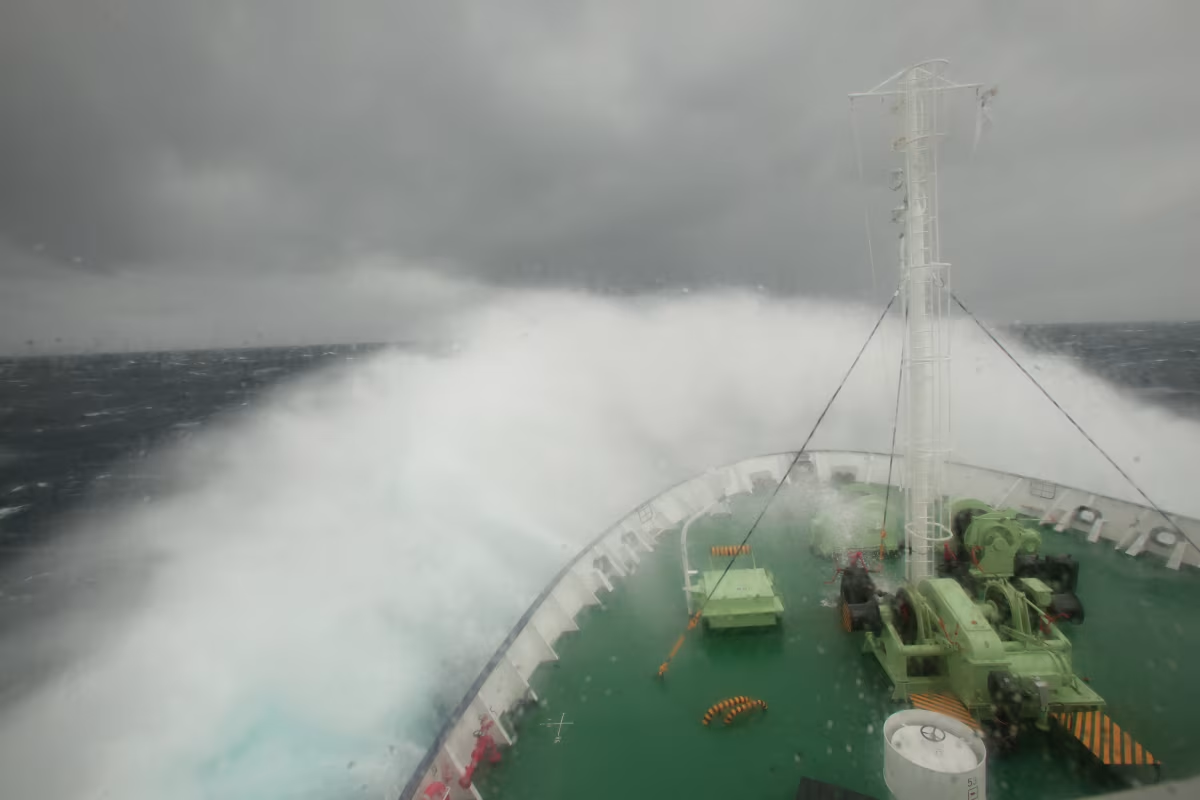
Picture by Rutker Stellke
Time on shore
We try to spend as much time on shore as possible. Exactly how much time any one expedition will spend ashore can vary widely depending on the weather, the distance to shore, and time constraints. You may spend several days aboard ship and then make two or three excursions to land on the next day.
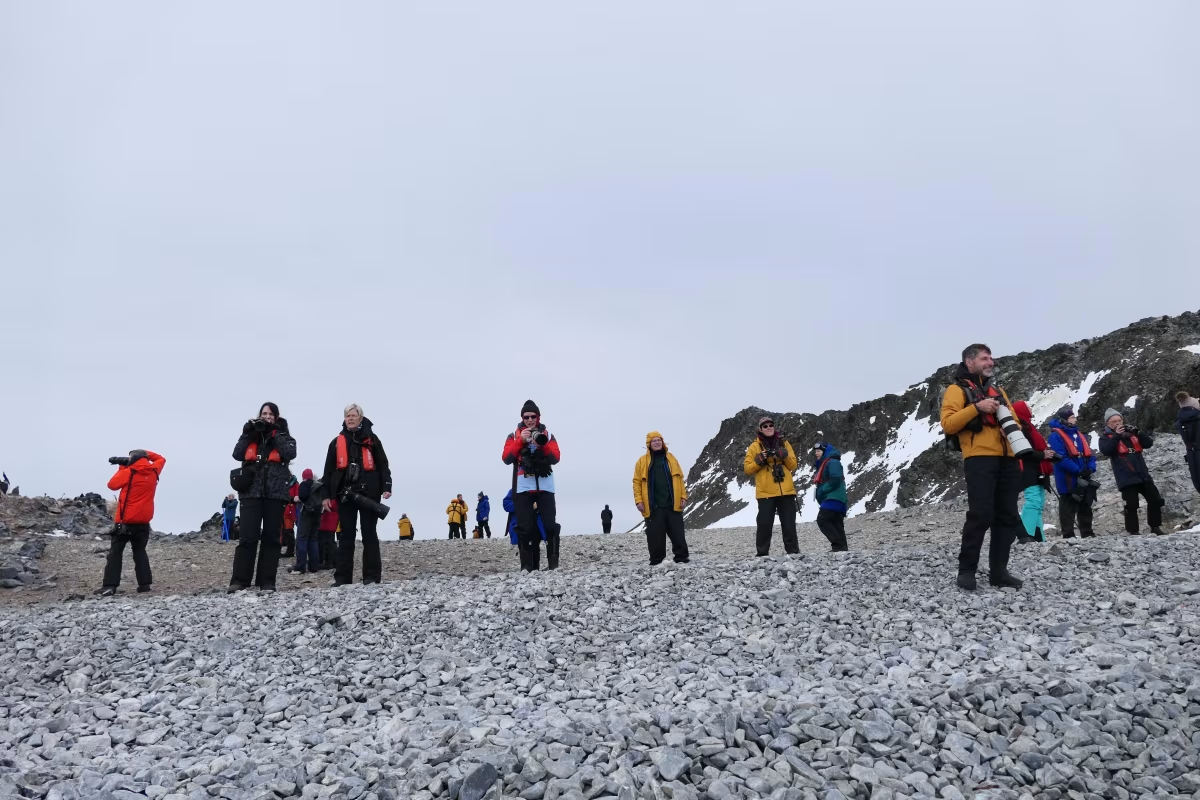
Vaccinations
You can find our regularly updated COVID vaccine requirements and safety measures on our website. If you are traveling from or through countries where yellow fever is a risk (certain parts of Asia, Africa, or South America), you may also need relevant vaccinations. Your government’s health organizations should have information with regard to other vaccines you may need.
Wildlife
Antarctic fauna - Apart from the deep sea, Antarctica is the oldest and largest self-contained ecosystem in the world. The animal world is very closely linked with the sea and is consequently to be found mainly on the periphery of the continent. With the exception of a few insects, all forms of life capitulate in the face of the increasingly harsh climatic conditions further inland. The coastal regions are populated by sea birds such as petrels, albatrosses, skuas and penguins as well as marine mammals like the crabeater seal, leopard seal, Ross seal, Weddell seal, fin and right whale, and sea lions. The Antarctic sea regions contain the greatest quantities of animal protein on Earth.
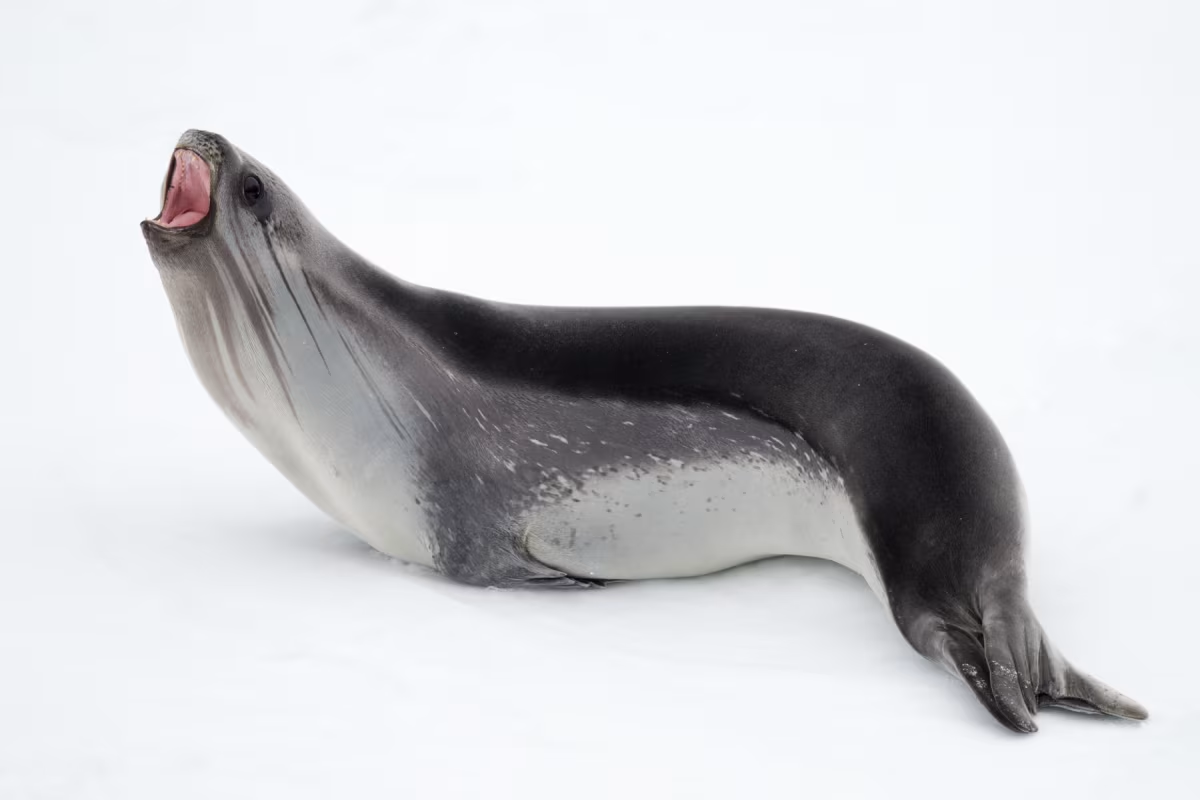
Picture by Rolf Stange
Antarctica’s marine food chain - The most common Antarctic shrimp, krill, uses its front legs to catch microscopic unicellular algae known as diatoms. The word “krill” comes from the Norwegian and means “food of the whale”. All living creatures consume 90% of their food for their everyday activities and thus convert only 10% into body weight, meaning that nutritional value declines exponentially as one progresses through the food chain. The whale jumps these links in the chain by preying directly on krill rather than on fish or sea birds. A fin whale requires about 2-3 tonnes of krill per day to reach an impressive length of 24 metres and a weight of up to 80 tonnes.
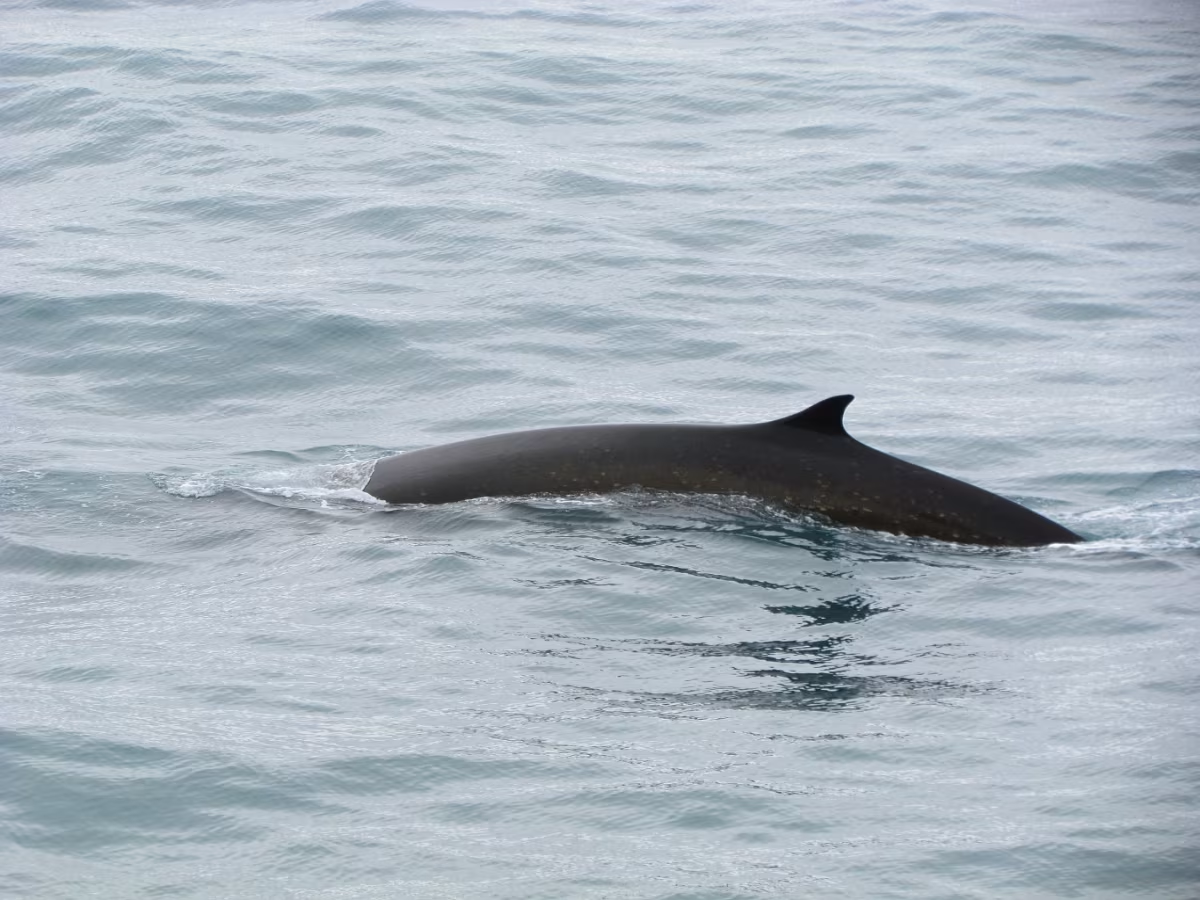
Picture by Ali Liddle
Antarctic birds - Penguins represent half of the Antarctic bird population, nine-tenths of its biomass. These birds depend on the sea for their food. They eat about 4.7 million tons of food each month - mainly crustaceans and fish, but also squid.
While penguins dominate the bird biomass, tube-nosed petrels constitute the majority of the breeding species. Other groups include cormorants, skuas, gulls, and terns. It takes a tough bird to overcome Antarctica’s notorious inclemency.
- One might infer from the enormous concentrations of sea birds that the populations are invincible. They are not. The long isolation of Antarctic birds has produced an extraordinarily innocent and docile quality in the birds – a quality attractive to both scientific study and tourism, but one that leaves these highly vulnerable birds open to harm from human presence or mismanagement.
- Also, natural factors such as storms or abnormally extensive sea ice can cause extremely high mortality in nesting areas. But Antarctic bird species have evolved to overcome these adversities.
- Human activity is another matter. On the evolutionary time scale, people and their machines have just entered the Antarctic scene. The birds have had little time to adjust. Studies have shown that even casual or occasional contacts with Antarctic bird colonies can adversely affect breeding success. After visits are ended or controlled, bird populations have been observed to return to former levels.
- Today, much is known about some of these birds at breeding sites, but virtually nothing about the longer time they spend at sea.
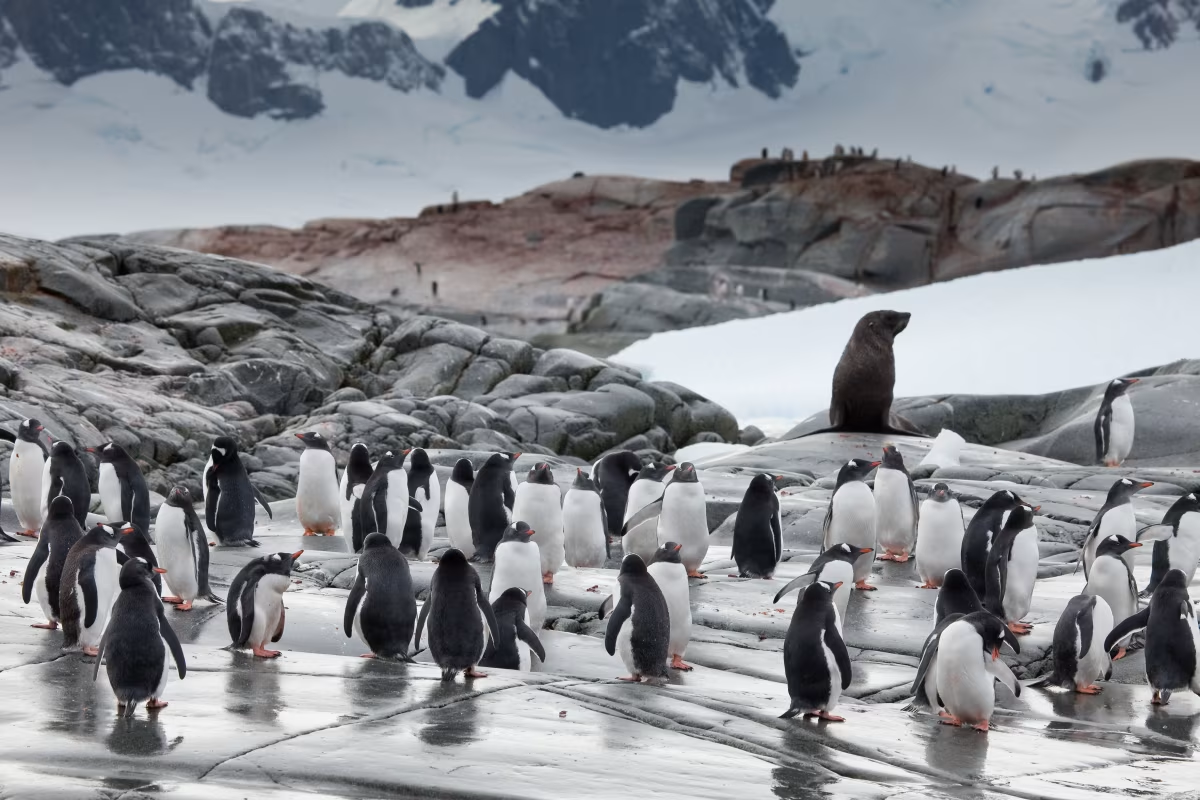
Picture by Hanneke Dallmeijer
Antarctic flora - “Infertile” and “wasteland” are two words one often hears in connection with the polar regions. There are only two species of flowering plants on the Antarctic mainland since it is a long way from the next continent, a fact which reduces the chances of new plant species becoming established.
- The major part of Antarctica is also covered by eternal ice and the climate is much harsher than in most parts of the Arctic. In the few places where plants can grow, mosses and lichens play a bigger role than flowering plants.
- Some lichens even grow in the polar desert areas in the interior of Antarctica where the conditions are truly extreme.
- Polar plants have to be very small to survive. A tall plant would be helplessly exposed to the sharp ice crystals with which the wind would constantly batter it.
Zodiac outings
Zodiacs are small, rubber, air-inflated boats that allow us to zip away from our big ships to go in for landings or to explore narrow waterways. They’re lots of fun to ride in and let us get fairly close to wildlife but they require a bit of caution to make sure everything runs smoothly.
Also, expect to get wet.
- The Zodiac driver is the boss! Follow their suggestions and you’ll have a fun and safe time.
- Always wear the provided safety vests.
- Our lovely and helpful Zodiac crews will offer you a helping hand when getting into the boat or getting out of the boat and onto the land. Always accept, preferably with a “sailor’s grip” (gripping each other’s wrists instead of hands) because it will give you a much stronger grip.
- It’s backpack time! If you have a bunch of small items you’re bringing along like extra clothing or cameras, stick it in your waterproof backpack. You’re going to want to always have both of your hands free. If you bring something that won’t fit in your backpack, hand it to the Zodiac’s driver and they’ll store it for you.
- Smoking in the Zodiacs is a BIG NO-NO! There are gas fumes around the motors, plus a lit cigarette is not particularly helpful when your boat’s integrity depends on its rubber not being melted.
- We’ll announce what kind of conditions you can expect – weather, and whether or not it will be a “wet” landing (heading ashore requiring stepping into water to get out of the boat) or a “dry” landing (use of a dock).
- Your driver will instruct you when it’s safe to disembark and how you should do so. Generally your best bet is to sit on one of the pontoons and then swing your legs around. You should never attempt to disembark over the wooden stern of the boat (the rear end) because the heavy motors and their blades pose a danger.

Picture by Elke Lindner
